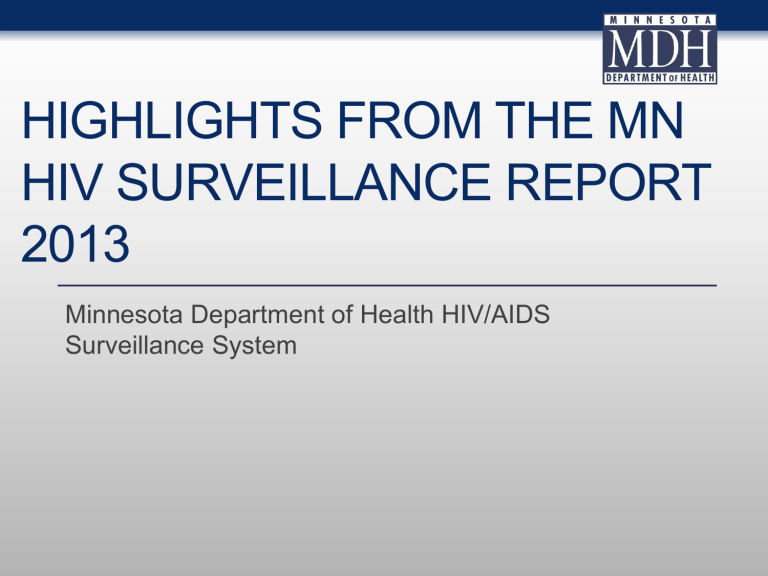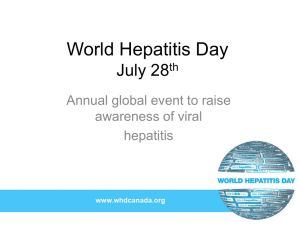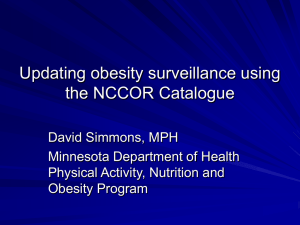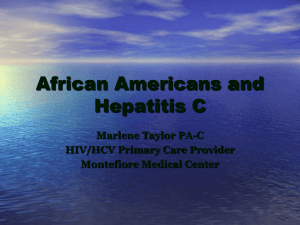Highlights from the MN HIV Surveillance Report 2013

HIGHLIGHTS FROM THE MN
HIV SURVEILLANCE REPORT
2013
Minnesota Department of Health HIV/AIDS
Surveillance System
Estimated Number of Persons
Living with HIV/AIDS in Minnesota
• As of December 31, 2013, 7,723* persons are assumed alive and living in Minnesota with HIV/AIDS
• 4,095 living with HIV infection (non-AIDS)
• 3,628 living with AIDS
* This number includes persons who reported Minnesota as their current state of residence, regardless of residence at time of diagnosis. Includes state prisoners and refugees arriving through the HIV+ Refugee Resettlement Program, as well as HIV+ refugee/immigrants arriving through other programs.
Minnesota HIV Treatment
Cascade
Percentage of persons diagnosed with HIV engaged in selected stages of the continuum of care – Minnesota
Conclusions
• There were 301 new HIV diagnoses reported in Minnesota in 2013, a decrease of 4% from 2012
• Great disparities in HIV diagnoses persist among populations of color and American Indians living in
Minnesota
• Male-to-male sex remains the leading risk factor for acquiring HIV/AIDS in Minnesota
• New HIV diagnoses remain concentrated in the Twin Cities seven-county metro area (82% of new diagnoses in 2013)
• Foreign-born persons made up nearly 1 in 5 of new HIV diagnoses in 2013, and progress from HIV to AIDS more quickly than U.S. born persons living with HIV in Minnesota
Thank You!
For more information, please contact:
Jessica Brehmer, HIV/AIDS Epidemiologist jessica.brehmer@state.mn.us
(651) 201-5624
“The place where two discriminations exist is a dangerous place to live.”
- Richard (Anguksuar) LaFortune
Using Public Health Programming to
Mitigate Disease and Death from Opiate
Drug Use
Sarah Gordon, MPH, NREMT-B
The issue is not simple….
disease, heroin, death, stigma, addiction, war on drugs, healthcare access, harm reduction
Injection drug use is a well-known route of transmission of blood borne infections, particularly HIV and hepatitis B and C. Use of illicit drugs is associated with increased rates of TB and STDs.
Recommended approaches, immunizations and screening, can protect the health of a person who uses drugs through medical interventions, while evidence-based behavioral interventions help prevent sexual and injection transmission by addressing risky behaviors.
Increase in Opiate Use In Minnesota
2005 - 2011
Maps show grams per 10,000 people of prescriptions for painkiller opiates (such as oxycodone, hydrocodone, codeine, morphine) in each three-digit ZIP code area. Source: Drug Enforcement
Administration.
TwinCities.com DATA 2014
Heroin Influx in Midwest
Courtesy Carol Falkowski Drug Abuse Trends
June 2013, Drug Abuse Dialogues
Twin Cities has the cheapest and strongest heroin in the country, officials say
By Aaron Rupar Thu., Jun. 6 2013 at 1:04 PM
At the newser, a doctor said there were four heroin-related deaths reported in Hennepin County in 2008. Last year, that number shot up to 37, and Hennepin County Sheriff Rich Stanek said the county is on pace to set a new record this year.
Stanek also said the heroin he's seeing these days in Hennepin County is the cheapest and strongest in the country, a combination he characterized as particularly deadly.
His comments reiterated what law enforcement officials said at a similar news conference last year . Then, they referenced an analysis showing that some heroin found on Twin Cities' streets was up to 93 percent pure, whereas typical American street heroin has a purity of about 35 percent.
"A heroin user in the Twin Cities has a greater chance of accidental overdose because the purity of that heroin is so high," Stanek said during that news conference.
At today's newser, officials pointed out the role prescription drugs play as a gateway to heroin. According to the Star Tribune , data showed that heroin and prescription drug abuse in the Twin Cities reached an all-time high last year. The two accounted for 21 percent of all addiction treatments in the state, with only alcohol abuse accounting for a higher share.
Courtesy Carol Falkowski, Drug Abuse Trends
June 2012, Drug Abuse Dialogues
Heroin vs. other opiate treatment admission
1998-2013
Slide courtesy Rick Moldenhauer, DHS
Source: DAANES, PMQI, MN DHS 2014
CDC Declares an Epidemic
• In 2010, overdose death become the leading cause of injury death in the US
80
60
40
20
0
Local Impact – Hennepin/Ramsey
County Drug Deaths
140
120
100
Opiates
Cocaine
Methamphetamine
2006 2007 2008 2009 2010 2011 2012
Hennepin County Medical Examiner and Ramsey County Medical Examiner, 2013
What makes opioid users at particular risk of overdose fatality?
• Among patients receiving opioid prescriptions for pain, higher opioid doses were associated with increased risk of opioid overdose death.
• Bohnert, et al. 2011
• Poly-drug use
• Bohnert, et al. 2011
• Substance use disorders and co-occuring mental health disorders
• Hall, et. al., 2008
• Purity! Mexican heroin purity in Minneapolis highest in country and sold at lowest cost
• DEA Domestic Monitoring Program 2009
What makes opioid users at particular risk of overdose fatality?
(continued)
Fear!
• Fear of police response was the most commonly cited reason for not calling or delaying before calling for help
• Efforts to equip drug users to manage overdoses effectively, including training in first aid and the provision of naloxone, and the reduction of police involvement at overdose events may have a substantial impact on overdose-related morbidity and mortality.
– Tracy, et al. Drug and Alcohol Dependence. 09/2005
Reality of drug use….
• Non-fatal overdose in injection drug users
– Lifetime prevalence ~ 40%
– Of these ~ 70% reversed by naloxone
– Lifetime witnesses ~ 90%
• Fatal
– 1-3 hour window for medical intervention
• Sackoff et al. Ann Int Med,
2006; Ermak et al. 2009
The other reality of drug use….
Public Health Programming to
Prevent Disease
Role of Needle Exchange in HIV and
Hepatitis C Prevention Efforts
• The public health approach to disease prevention is to reduce risk of infection whether individual stops the risk behavior or not, which thereby protects the health of the community
Syringe Exchange is low-threshold entry point for drug users into prevention services and treatment
• Exchange participants 5x more likely to enter drug treatment than nonparticipants
• 67% of all exchange programs offer HCV testing and 87% offer HIV testing and linkage to care
• Since implementation of exchange programs in the late ’80s, HIV rates in injection drug users decreased overall by 80 %
Syringe Exchange Promotes Public
Safety
• Post implementation of syringe exchange programs reduce number of syringes found in public areas….
– 50% drop in Baltimore
– 2/3 reduction in Portland, OR
• Implementation of syringe exchange programs reduces needle-stick injuries to police….
– 2/3 injury reduction for
Connecticut law enforcement
– 66% reduction for Macon
County, NC law enforcement
Testing is Prevention!
• 2 good reasons to get tested for HIV and HCV
– If you have HIV and/or HCV, you can get treatment and healthy lifestyle education that may help you live a longer, healthier life.
– If you do not have HIV or HCV, you can learn how to stay that way.
• Studies show persons who are aware of their status decrease behaviors that help transmit infection
911 Good Samaritan Laws
• Purpose: increase overdose survival rates by encouraging overdose witnesses to seek medical help through limited immunity from arrest and prosecution for minor drug and alcohol violation
• Good Sam laws do not protect from arrest for other offenses, such as selling or trafficking, or driving while drugged
• 15 states and District of Columbia have Good Sam policies
– New Mexico, California, Colorado, New Jersey, New York, Rhode
Island, Illinois, Florida, Massachusetts, Connecticut, North
Carolina, Vermont, Delaware, Georgia, and Washington
Broadening Naloxone Access
• Broader naloxone access policies puts overdose antidote in the hands of witnesses, first responders, community prevention programs
– High affinity opioid receptor antagonist
– Rapidly absorbed via IV, IM, SC, IN routes
– Half-life ~ 40 minutes
– Non-abusable
– Adverse effect – withdrawal
– Shelf-life – 3 years
What is the Overdose Antidote?
An Opiate Antagonist
What’s coming in MN?
Steve's Law (HF2307 /
SF1900) https://www.facebook.com/#!/911GoodSamar itanNaloxoneCampaign
Thank you!!
For more information, please contact:
Sarah Gordon, MPH
Coordinator, HIV Testing and Syringe
Services Programs
Minnesota Department of Health
651-201-4011 sarah.gordon@state.mn.us
Hepatitis A, B & C in
Minnesota, 2013
Minnesota Department of Health
Hepatitis Surveillance System
Minnesota Hepatitis Surveillance System
Hepatitis B reportable since 1987
Hepatitis C reportable since 1998
Passive data collection
Viral Hepatitis Overview
Introduction
Data in this presentation are current through 2013
Definitions:
Acute case:
Infected within the last six months
Symptomatic OR negative test in six months before diagnosis
Chronic case:
Infected for over six months
Asymptomatic or symptomatic
Resolved cases:
No evidence of current infection
Evidence of past infection
Data Source: Minnesota Viral Hepatitis Surveillance System
Data limitations
The slides rely on data from HCV and HBV cases diagnosed through 2013 and reported to the Minnesota Department of Health (MDH) Hepatitis
Surveillance System.
Some limitations of surveillance data:
Data do not include hepatitis-infected persons who have not been tested
Data do not include persons whose positive test results have not been reported to the MDH
Persons are assumed to be alive unless the MDH has knowledge of their death.
Persons whose most recently reported state of residence was Minnesota are assumed to be currently residing in Minnesota unless the MDH has knowledge of their relocation.
Data Source: Minnesota Viral Hepatitis Surveillance System
Acute Viral Hepatitis
Acute case:
Infected within the last six months
Symptomatic OR negative test within 6 months before diagnosis
Reported rate per 100,000 population of acute viral hepatitis
United States, 1998-2011
Data Source: Viral Hepatitis Statistics & Surveillance at www.cdc.gov/hepatitis/Statistics/2011Surveillance/index.htm
Number of Acute* Cases per year Minnesota,
1998-2013
Data Source: MN Viral Hepatitis Surveillance System *Acute cases include seroconverters for all years for HBV and HCV
Chronic Viral Hepatitis
Overview of Chronic HBV in MN
Chronic case:
Infected for over six months
Includes cases with no evidence of recent infection
Asymptomatic or symptomatic
Reported Number of Persons with Chronic HBV in MN
As of December 31, 2013, 21,585* persons are assumed alive and living in MN with chronic HBV
*Includes persons with unknown city of residence
Note: Includes all chronic, and probable chronic cases.
Data Source: MN Viral Hepatitis Surveillance System
Persons Living with HBV in MN by Current Residence,
2013
Total number with residence information = 21,242
(343 missing residence information)
Metro = Seven-county metro area including Anoka, Carver, Dakota, Hennepin, Ramsey, Scott, and Washington counties.
Greater MN = All other Minnesota counties, outside the seven-county metro area.
Data Source: MN Viral Hepatitis Surveillance System
Persons with Chronic HBV in MN by Age, 2013
Median Age: 43
Data Source: MN Viral Hepatitis Surveillance System
Chronic HBV in MN by Gender, 2013
Data Source: MN Viral Hepatitis Surveillance System
Persons Living with Chronic HBV in Minnesota by Race,
2013
Amer Ind
0%
Other
1%
Hispanic
1%
White
11%
Unknown
16%
Asian
44%
Data Source: MN Viral Hepatitis Surveillance System
Afr Amer
27%
Persons with unknown race=3,365
Afr Amer = African American /Black Asian=Asian or Pacific Islander
Amer Ind = American Indian
Other = Multi-racial persons or persons with other race
Persons Living with Chronic HBV in Minnesota by Race rates (per 100,000 persons*), 2013
Data Source: MN Viral Hepatitis Surveillance System
*Rates calculated using 2010 U.S. Census data
Excludes 3,396 cases with multiple races and unknown race
Overview of HCV in Minnesota
A hepatitis C case is defined as current or past infection with hepatitis C and includes:
Acute cases:
Infected within the last six months
Symptomatic
Chronic cases:
Infected for over six months
Resolved cases:
No evidence of current infection
Evidence of past infection
Reported Number of Persons
Living with HCV in MN
As of December 31, 2013, 40,943* persons are assumed alive and living in MN with HCV
*Includes persons with unknown city of residence
Note: Includes all acute, chronic, probable chronic, and resolved cases.
Data Source: MN Viral Hepatitis Surveillance System
HCV Infected Persons Identified through Passive
Surveillance in MN through 2013
N=84,863**
40,943
Estimated unidentified HCV infected persons
HCV infected persons* identified through passive surveillance
43,920
Data Source: MN Viral Hepatitis Surveillance System
*Includes all acute, chronic, probable chronic, and resolved cases.
**http://www.cdc.gov/ncidod/diseases/hepatitis/c/fact.htm
Persons Living with HCV in MN by Current Residence,
2013
Total number with residence information= 40,033
(1,271 missing residence information)
Suburban = Seven-county metro area including Anoka, Carver, Dakota, Hennepin (except Minneapolis), Ramsey (except St. Paul), Scott, and Washington counties including those in Hennepin County or Ramsey County with unknown city. Greater MN = All other Minnesota counties, outside the seven-county metro area.
Data Source: MN Viral Hepatitis Surveillance System
Persons Living with HCV in MN by Age, 2013
Median Age: 56
Data Source: MN Viral Hepatitis Surveillance System
Persons Living with HCV in MN by Gender*, 2013
Data Source: MN Viral Hepatitis Surveillance System
*Includes anonymous methadone patients
Persons Living with Chronic HCV in Minnesota by Race,
2013
Afr Amer = African American /Black Asian=Asian or Pacific Islander
Amer Ind = American Indian
Other = Multi-racial persons or persons with other race
Persons Living with HCV in Minnesota rates (per 100,000 persons*), 2013
*Rates calculated using 2010 U.S. Census data
Excludes persons with multiple races or unknown race
Data Source: MN Viral Hepatitis Surveillance System
Hepatitis C in Populations of Interest
Hepatitis C in young adults under age 30
Reported Number of Persons <30
Living with HCV in MN
As of December 31, 2013, 1,764* persons under the age of 30 are assumed alive and living in MN with HCV
*Includes persons with unknown city of residence
Note: Includes all acute, chronic, probable chronic, and resolved cases.
Data Source: Minnesota Viral Hepatitis Surveillance System
Persons <30 Living with HCV in MN by Current Residence, 2013
MN Overall
MN Age Under 30 years
Total number with residence information= 40,333 Total number with residence information= 1,745
Suburban = Seven-county metro area including Anoka, Carver, Dakota, Hennepin (except Minneapolis), Ramsey (except St. Paul), Scott, and Washington counties including those in Hennepin County or Ramsey County with unknown city. Greater MN = All other Minnesota counties, outside the seven-county metro area.
Data Source: Minnesota Viral Hepatitis Surveillance System
Persons <30 Living with HCV in MN by Gender*, 2013
MN Overall
MN Age Under 30 years
*Includes anonymous methadone patients
Data Source: Minnesota Viral Hepatitis Surveillance System
Persons <30 Living with HCV in MN by Race, 2013
MN Overall
MN Age Under 30 years
Suburban = Seven-county metro area including Anoka, Carver, Dakota, Hennepin (except Minneapolis), Ramsey (except St. Paul), Scott, and Washington counties including those in Hennepin County or Ramsey County with unknown city. Greater MN = All other Minnesota counties, outside the seven-county metro area.
Data Source: Minnesota Viral Hepatitis Surveillance System
Hepatitis C in American Indians
Reported Number of American Indian Persons
Living with HCV in MN
As of December 31, 2013, 2,073* persons who identify as American Indian are assumed alive and living in MN with HCV
*Includes persons with unknown city of residence
Note: Includes all acute, chronic, probable chronic, and resolved cases.
Data Source: Minnesota Viral Hepatitis Surveillance System
American Indian Persons Living with HCV in MN by
Current Residence, 2013
MN Overall
MN American Indian
Total number with residence information= 40,333 Total number with residence information= 2,058
Suburban = Seven-county metro area including Anoka, Carver, Dakota, Hennepin (except Minneapolis), Ramsey (except St. Paul), Scott, and Washington counties including those in Hennepin County or Ramsey County with unknown city. Greater MN = All other Minnesota counties, outside the seven-county metro area.
Data Source: Minnesota Viral Hepatitis Surveillance System
American Indian Persons Living with HCV in MN by Age, 2013
Median Age: 51
Data Source: Minnesota Viral Hepatitis Surveillance System
Persons Living HCV in MN by Gender*, 2013
MN Overall
MN American Indian
*Includes anonymous methadone patients
Data Source: Minnesota Viral Hepatitis Surveillance System
Hepatitis C Treatment
Hepatitis C Treatment Changes
Direct acting antiviral agents approved in the U.S.
Improved rates of sustained virologic response
Rapidly changing recommendations hcvguidelines.org
Thank you!
For more information please contact:
Kristin Sweet
651.201.4888
kristin.sweet@state.mn.us
QUESTIONS?
Jessica Brehmer, MPH, HIV Epidemiologist, MDH
651-201-5624, jessica.brehmer@state.mn.us
Sarah Gordon, MPH, Coordinator, HIV Testing and
Syringe Services Programs, MDH
651-201-4011, sarah.gordon@state.mn.us
Kristin Sweet, MPH, Hepatitis Epidemiologist, MDH
651-201-4888, kristin.sweet@state.mn.us




